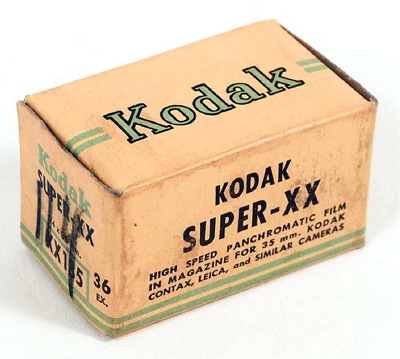 [From his own account and all other evidence, we know for a certainty that, after making his handful of exposures on the Easy Red sector of Omaha Beach on D-Day, Robert Capa returned to the ship that had brought him to Normandy, the USS Samuel Chase, in order to carry the entirety of his invasion coverage personally back across the English Channel to Portsmouth, on the English coast. There he turned it over to a military courier for transportation to Supreme Headquarters Allied Expeditionary Forces (SHAEF), under whose watchful eye it got processed and went through a rigorous censorship process before, ultimately, the approved images got delivered to assistant picture editor John Morris at LIFE‘s London office for use in that magazine and distribution to the picture pool.
[From his own account and all other evidence, we know for a certainty that, after making his handful of exposures on the Easy Red sector of Omaha Beach on D-Day, Robert Capa returned to the ship that had brought him to Normandy, the USS Samuel Chase, in order to carry the entirety of his invasion coverage personally back across the English Channel to Portsmouth, on the English coast. There he turned it over to a military courier for transportation to Supreme Headquarters Allied Expeditionary Forces (SHAEF), under whose watchful eye it got processed and went through a rigorous censorship process before, ultimately, the approved images got delivered to assistant picture editor John Morris at LIFE‘s London office for use in that magazine and distribution to the picture pool.
In a previous Guest Post series, military historian Charles Herrick dug out the documentation and painstakingly tracked the route Capa’s films would have taken before Morris actually got his hands on them. His analysis made it clear that, in order to meet LIFE‘s deadline for its upcoming D-Day issue, Capa believed he had no choice but to leave the invasion front in order to ensure the timely arrival of his films at LIFE on the evening of June 7.
But that still left several questions unanswered:
- While on Easy Red, Capa presumably had another option — that of turning his film over to a military courier assigned to that sector of the beachhead for transport to England, according to a plan put in place by SHAEF. This would have enabled him to stay with the troops and cover the first days of the invasion from the front — the story of a lifetime, a war photographer’s dream assignment. Why didn’t he do so, and what would likely have ensued with his films had he made that choice?
- What system did SHAEF in fact have in place to transmit news reports, photographs, and films generated by accredited journalists from the invasion front? And how did that work out?
Several pertinent articles that I came across earlier this year made it clear that these questions needed answering, as part of our investigation. Those were:
 “The First D-Day Documentary,” by Steve Greene, posted on September 9, 2014 in the “Military, Motion Pictures” section of “The Unwritten Record.” This is a blog for staffers in the Special Media Archives Services Division of the National Archives. Greene is the Special Media Holdings Coordinator for the Presidential Libraries System. Previously, he was the audiovisual archivist for the Nixon Presidential Materials — serious credentials indeed.
“The First D-Day Documentary,” by Steve Greene, posted on September 9, 2014 in the “Military, Motion Pictures” section of “The Unwritten Record.” This is a blog for staffers in the Special Media Archives Services Division of the National Archives. Greene is the Special Media Holdings Coordinator for the Presidential Libraries System. Previously, he was the audiovisual archivist for the Nixon Presidential Materials — serious credentials indeed.- “One man dumped most of the combat footage of D-Day into the English Channel,” by Blake Stilwell, published at the website wearethemighty.com on June 6, 2017. We Are The Mighty describes itself as “Americas [sic] Military Entertainment Brand: Military Entertainment for America by Veterans,” while Stilwell describes himself as “a traveler and writer with degrees in design, television & film, journalism, public relations, international relations, and business administration. He is a former combat photographer with experience in politics, entertainment, development, nonprofit, military, and government. His career includes work in Business Insider, Fox News, ABC News, NBC, HBO, and the White House.” More serious credentials.
These two accounts — the second clearly based on the first — address another D-Day legend concerning damaged/lost film. This one intersects with our research, since the standard narrative has LIFE staffer Bob Landry’s films from D-Day on Utah Beach getting lost in this notorious incident. So I asked Herrick to grab his pick and shovel yet again, in order to excavate the relevant materials from the military archives.
I find what he dug up both fascinating and illuminating, and hope you will too. The first part appears below; click here for Part 2. — A.D.C.]
•
Legend of the Lost Film
by Charles Herrick
•
Legends are devious little creatures. They take root in the most unlikely places and flourish on the most ridiculous ideas. They entrance the popular imagination, subvert critical thought and, like weeds, choke out facts and reality. We need only look to the legendary loss of Capa’s film in a darkroom accident, a fable that had gone unquestioned for seventy years. And where one urban legend thrives, it is not uncommon for similar legends to sprout. So it is that D-Day has not just Capa’s myth but two more “lost film” legends.
Probably the least known involves the automatic cameras used on D-Day. Hundreds of these were mounted on landing craft and tanks, rigged to start filming as soon as the craft’s ramp dropped, or the tank fired its gun.[1] Although these cameras were used by Canadian, British and U.S. forces, very little film has survived. In fact, it appears none of the film from the dozens of automatic cameras used at the U.S. beaches may have survived.
Legend has it that all the film from the U.S. cameras was collected and placed on a single aircraft, which then crashed into the ocean. That’s absurd, of course. At no point would all the film from all those cameras be on the same aircraft. While that explanation is plainly incorrect, the mystery endures: Just what did happen to all that film? That however, is a question for another time.
The third “lost film” legend is better known, and is the focus of this article.
Underwater at Utah
This “lost film” tale centers on Utah Beach, though its many versions vary so wildly that it is difficult to define. In brief, the D-Day film from that beach was supposedly entrusted to a courier who then accidentally dropped it into the ocean while climbing aboard a ship. In some versions this package also included film from Omaha Beach. Other versions claim the loss included film from cameramen who jumped in with the paratroopers, placing the incident a few days after D-Day, when the seaborne invaders linked up with the airborne forces. Another version claims the loss included film shot by John Ford’s documentary team,[2] which Ford never mentioned and in fact indirectly ruled out. Some versions insert a Navy beachmaster into the mix, claiming he handed the film to the hapless courier. There seems to be a version to meet every need.
By the time the documentary Shooting War: World War II Combat Cameramen (produced by Steven Spielberg, written by Richard Schickel) aired in 2000, the story had spiraled out of control. Tom Hanks’s narration thereof states,
“The Signal Corps cameramen live with a bitter irony. Almost the entire surviving photographic record of D-Day on the American beaches was shot by Coast Guard cameramen. The film exposed by [Walter] Rosenblum and the other men of the 165th Photo Company on the beaches would be lost. … By the end of the day, the cameramen were ready to surrender their hard-won footage.”
The film then cut to a clip of George Douglas (Doug) Wood, a member of the 165th Photo Signal Company, saying:
“We turned our footage into the beachmasters and they sent a colonel over who went to each beachmaster and picked up the film, put it all into a duffel bag, put it on his shoulder and [went] out to a ship. Going up the side of a ship he dropped it over the side and all the film was lost.”
The problem is that Doug Wood apparently wasn’t there on D-Day; it seems he did not land until June 11 or 12.[3] [Editor’s note: You can view this film, in segments, on YouTube. For the passage cited above, see the first two minutes of segment 5. — A.D.C.] Rather than offering proof of the legend, his account seems, at best, a secondhand rumor, surfacing some 55 years after the fact. Additionally, the detail of the beachmasters undercuts the credibility of the anecdote itself, as I’ll discuss later in this article.
•
We’ve already encountered this legend in our Robert Capa project. Recall that the film shot by Bob Landry (another LIFE photographer) had mysteriously disappeared on its way to London. Although John Morris (the assistant picture editor working with LIFE’s picture crew in London) was vague about the disappearance of this film in his 1998 autobiography (it “somehow got lost”)[4], in a 2015 interview he included new details: “Bob Landry landed on Utah Beach, and all his film, along with all the movie film and other films taken by army photographers, was accidentally dropped in the Channel on the way back to England.”[5]
In his book This is War! Robert Capa at Work (published in 2007; p. 240), Richard Whelan, Capa’s authorized biographer, also repeated the “dropped overboard” story and added details that implied he had a factual source: he named the clumsy colonel (Henderson) and stated the exact contents of the duffel bag — the film of ten cameramen. Whelan provided no source, and Henderson’s identity has remained elusive and mysterious. It appears both Morris and Whelan merely drew from the Shooting War documentary — a classic example of a self-replicating rumor.
The fact is that we have absolutely no original records that shed any light on this legend. Nothing from the Signal Corps records. Nothing from the Army Pictorial Services records. Nothing from SHAEF’s public-relations records. No mention in the official reports of the men whose film was supposedly lost. Despite an abundance of commentary on various aspects of the operation, none of the after-action reports even hints at such an accident. We haven’t even seen a contemporary letter home from a cameraman that mentions such an incident. It was only years later that the legend surfaced in the form of third-hand stories, devoid of any original basis in fact or even semi-reliable secondary sources.
In short, this particular “lost film” legend seems to be merely a miasma of self-reinforcing rumors with no factual basis. But that didn’t seem to stop its popularity.
Scapegoat
Yet another incarnation of the “dropped overboard” legend produced yet another villain. It began with a September 9, 2014 post on the National Archives website by Steve Greene in which he discussed recently rediscovered film of the D-Day landings (The First D-Day Documentary).[6] He repeated the “dropped overboard” legend in this manner: “Many fixed cameras mounted to landing craft were destroyed by fierce enemy fire, and an entire duffel bag filled with film shot in the first day of landings was reported lost overboard by an officer transporting the film for processing.” Greene was careful enough to caveat that assertion with the words “was reported,” rather than stating it as a fact. As we shall see, that fine distinction would be lost on at least one reader.
•
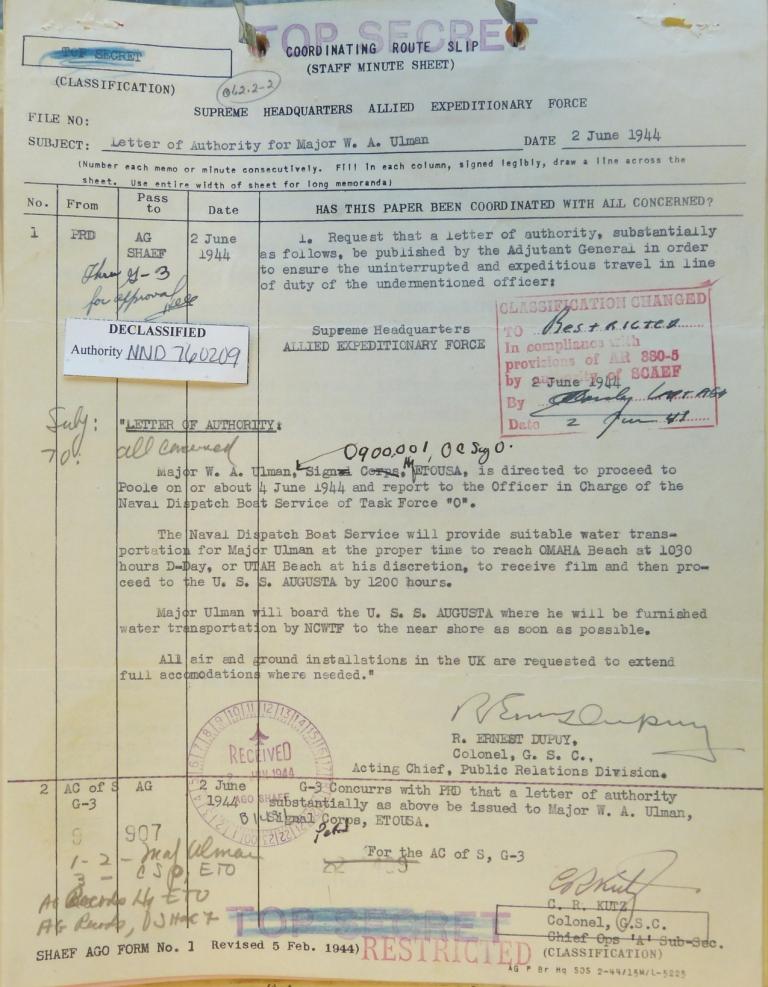
Figure 1. SHEAF internal staffing memo recommending Major Ulman be sent to Normandy on D-Day to pick up film (National Archives)
•
Immediately following that comment, the post included an image of a June 2, 1944 SHEAF internal staffing paper requesting orders for one Major W. A. Ulman to proceed to Normandy on D-Day to pick up film products and return them to London (Figure 1).[7] (That document also has factored into our project and accompanied “Guest Post 22: Doreen Landry Millichip on Bob Landry (b)”.) The placement of that image in the National Archives post suggested that Ulman was in fact the officer who lost the film, even though Greene’s text didn’t exactly say that.
Because Greene’s article was edited and posted on the National Archives site by a third person, one Audrey Amidon, we don’t know whether she or Greene made the decision to include the Ulman document in the post, nor whether that image was meant only as a general illustration or instead was specifically intended to point the finger at Ulman. [Note: Ms. Amidon works in the Motion Picture Preservation Lab, which is responsible for performing conservation and preservation work on motion picture records held across the National Archives. — A.D.C.]
Wherever there is that kind of ambiguity in a legend, it is certain to be interpreted in the most sensational manner. And so it was that on June 6, 2017, in a post at the website WeAretheMighty.com titled “One Man Dumped Most of the Combat Footage of D-Day into the English Channel,”[8] Blake Stilwell put the blame directly on Ulman, who, he stated, “unceremoniously dropped much of the footage shot on the American-led Omaha and Utah beaches into the English Channel.” As proof of this accusation, he linked to Greene’s post at the National Archives. But, as we’ve seen, Greene did not actually claim that. [Editor’s note: Stilwell’s “unceremoniously” adds insult to injury, suggesting that Ulman did this knowingly. — A.D.C.]
Stilwell’s post advanced the legend by asserting three points as fact: 1) Ulman was the culprit; 2) the film lost included not just that from Utah Beach, but film from Omaha Beach as well, and 3) the loss of the film in this manner was a fact, not an unsubstantiated rumor. All of these are incorrect.
•
The Curious Case of W. A. Ulman
Major W. A. Ulman was the number two man in SHAEF’s Army Pictorial Services organization, and did indeed receive orders for the mission outlined in the June 2, 1944 internal staffing memo.
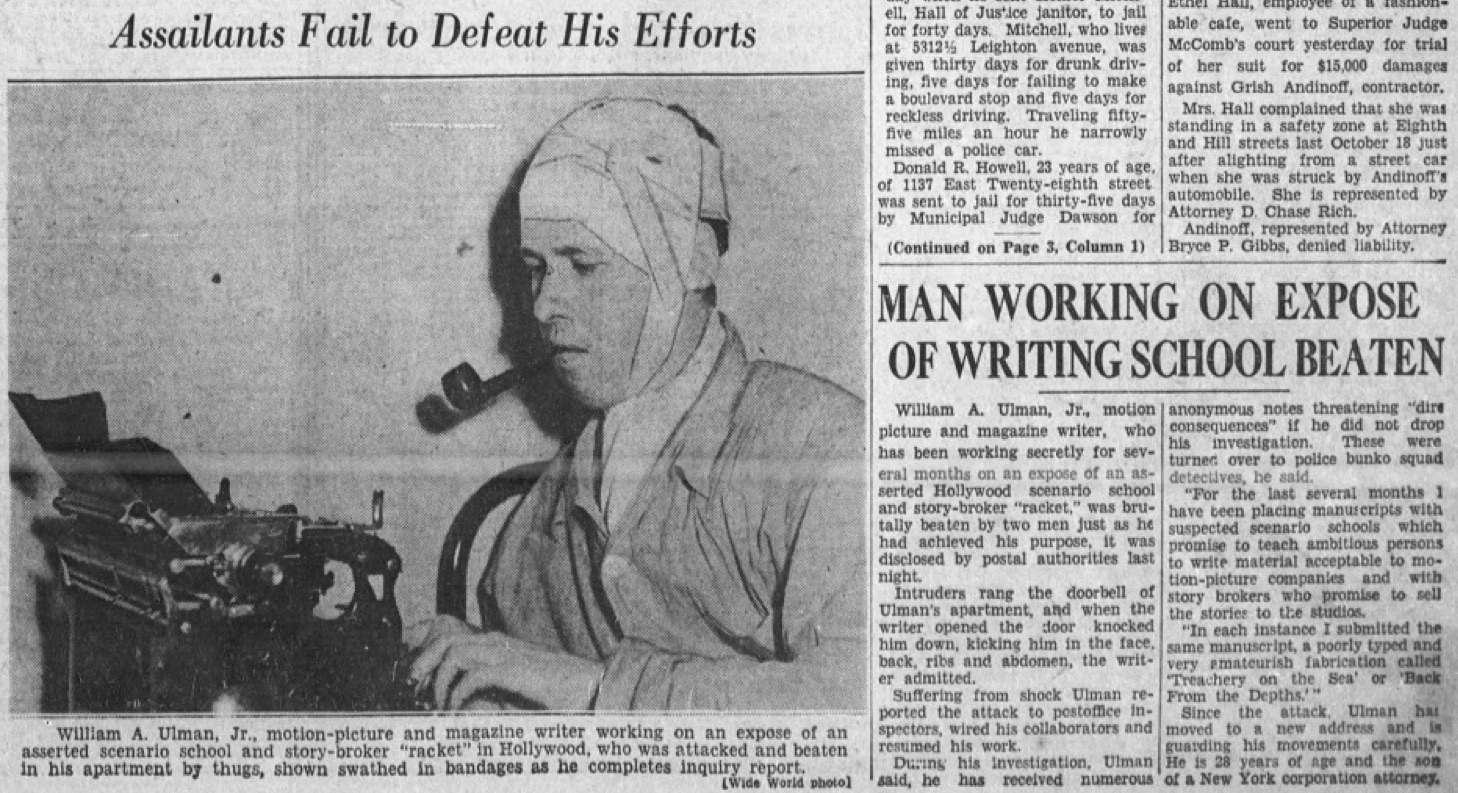
Figure 2. W. A. Ulman in a pre-war article in the February 9, 1935 issue of the Los Angeles Times newspaper (Courtesy of Tom Hogan)
Prior to the war he had worked in photography and on training films for AT&T; he also scripted and directed travelogues for Cinelog, and tried his hand at freelance writing in Hollywood. He both published articles in the Los Angeles Times and was featured in that paper as a victim of assault. (Figure 2) He had been promoted to lieutenant colonel on June 1, 1944, a detail the clerk missed when drawing up the internal staffing memo. (Figure 3)
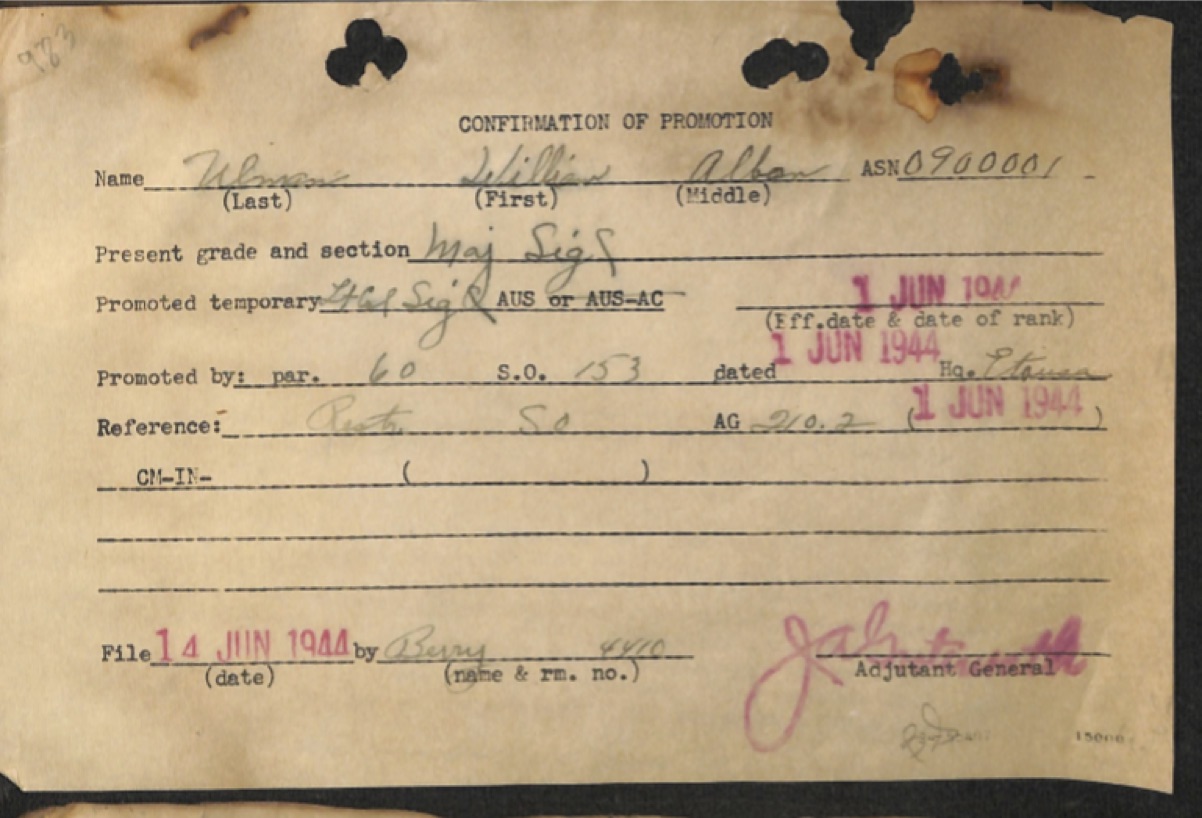
Figure 3. Confirmation of W. A. Ulman’s promotion on June 1, 1944, just prior to his D-Day mission. (Courtesy of Tom Hogan)
•
Assuming the staffing memo accurately reflected his final orders, Ulman was initially directed to report to the officer in charge of the Naval Dispatch Boat Service of Task Force “O,” which would serve both Omaha and Utah Beaches. Nine dispatch boats (small motor launches that normally served as harbor craft) were allocated to the Western Naval Task Force supporting the American beaches. Their mission was to provide a high-speed courier shuttle between the two American beaches, their command ships offshore, the Eastern Naval Task Force off Gold Beach,[9] and with the UK. Among their other duties, SHAEF counted on these boats to transport press material: “Every effort will be made to expedite the forwarding of press, radio and magazine copy, radio film recordings and photographic material. This material is authorized to be handled via official dispatch boats.”[10] Beginning on the afternoon of D-Day, the dispatch boats were supposed to make five runs a day.[11]
Ulman’s orders left it to his discretion whether he went to Omaha or Utah Beach, indicating that he was the sole designated courier for the two American beaches; otherwise a specific beach would have been identified for each courier. As SHAEF was an allied command, similar couriers were likely sent to the British and Canadian beaches, though we have no evidence they were.
In retrospect, Ulman’s mission appears more than a bit harebrained. Placing Ulman in the hands of the Dispatch Boat Service doesn’t seem to have made much sense, because that service wasn’t due to begin operating until the afternoon of D-Day, whereas Ulman was supposed to be at one of the beaches by 1030 hours. As it turned out, the dispatch boats did not operate at all for the first week of the invasion[12], so it isn’t at all clear how Ulman made it to Normandy on D-Day. But if we are to believe that Ulman was the agent of loss for so much film, then a couple of questions need to get answered. …
•
[1] Barney Oldfield, Never a Shot in Anger (Capra Press, Santa Barbara, 1986), p. 74.
[2] The Special Coverage Unit, operating for the Office of Strategic Services, had its own film crews present to document the landings.
[3] This is based on an email exchange with Kenneth Hackman. A friend of Wood’s, he authored a profile of him for the USAF Combat Camera website. His article included an extract from Wood’s Normandy letters.
[4] Morris, Get the Picture, Random House, New York (1998), p. 6.
[5] May 31, 2015 Financial Times interview with Simon Kuper.
[6] https://unwritten-record.blogs.archives.gov/2014/09/09/the-first-d-day-documentary/.
[7] SHAEF Coordinating Route Slip, Subject: Letter of Authority for Major W. A. Ulman, dated June 2, 1944.
[8] https://www.wearethemighty.com/articles/one-man-dumped-most-of-the-combat-footage-of-d-day-into-the-english-channel.
[9] Gold Beach was the next invasion beach to the east of Omaha Beach, and was the responsibility of the Second British Army.
[10] Change 3, p. 3, Western Naval Task Force Operation Plan 2-44, dated April 21, 1944.
[11] Change 1, p. 5, Western Naval Task Force Operation Plan 2-44, dated April 21, 1944.
[12] The United States Army in World War II; The Technical Services; The Signal Corps: The Outcome, Washington DC (1991), p. 109. The Provisional Engineer Special Brigade Group’s report was more straightforward. It stated that the boats, RAF seaplane tenders, arrived in such poor condition that they all required overhaul and only one was ready by the evening of D-Day. Provisional Engineer Special Brigade Group, Operation Report Neptune, Omaha Beach, September 30, 1944, pp. 313-15.
•
Text copyright © 2020 by Charles Herrick. All rights reserved.
•
(For an index of links to all posts in this series, click here.)
•
 Charles Herrick joined the U.S. Army in 1970 and graduated from the U.S. Military Academy at West Point in 1974. Commissioned in the Infantry, he earned the Ranger tab and Master Parachutist’s wings. He served in a variety of positions from company grade officer to the Pentagon. He earned the Combat Infantryman’s badge while assigned as the Operations Officer of the 193rd Infantry Brigade in Panama in 1989, and later graduated from the U.S. Army War College.
Charles Herrick joined the U.S. Army in 1970 and graduated from the U.S. Military Academy at West Point in 1974. Commissioned in the Infantry, he earned the Ranger tab and Master Parachutist’s wings. He served in a variety of positions from company grade officer to the Pentagon. He earned the Combat Infantryman’s badge while assigned as the Operations Officer of the 193rd Infantry Brigade in Panama in 1989, and later graduated from the U.S. Army War College.
Since retiring from the Army in 1996, Herrick has continued to work on defense issues as a contractor in East Asia, Latin America, the Balkans, Africa and Central Asia. He holds an MBA from the University of California at Los Angeles. He lives in California with his wife, where he pursues his passion for military history. To contact Charles Herrick, click here.


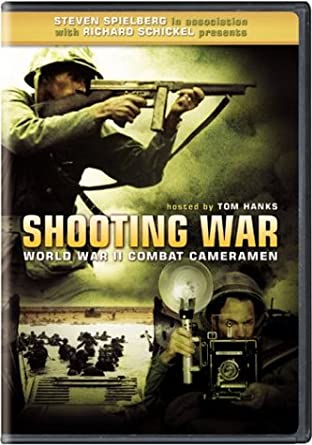
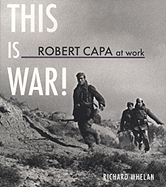





Greetings A.D Coleman -I’m wondering why writer W.A Ulman was beaten pre W.W 2 – Well have a great day and give Staten Island my best regards where old friends
yours truly Artist Peter Herley
Click on the image of the 1935 L.A. Times article at the bottom of this post to enlarge it, and you’ll get your answer. Apparently Ulman had undertaken an exposé of a for-profit school claiming to help amateur wannabes get into Hollywood scriptwriting, and got attacked for it. There may be more to this story; I haven’t pursued it to find out what school it was, what Ulman’s sleuthing uncovered, etc. All of that seems marginal to his role in the D-Day story. But this suggests that he had some journalistic skills, which may explain how he ended up with this assignment in Normandy.
To the extent that I represent it, Staten Island says hello back.
One gets the impression that it really doesn’t matter where you start digging. Pick any bit of popularly understood military history, and within a couple strokes of the pick you’re bound to find some sort of nonsense.
As William Barr reminded us recently, seemingly with no ironic intent, “History is written by the winners.” More broadly, we might amend that thus: “History” gets determined by those who get their versions into circulation most effectively.
Practitioners of historical research make a distinction between the chronicler and the historian. A chronicle gets written at or close to the time the event in question happened, usually by an eyewitness or someone who spoke directly with one or more eyewitnesses to the event — the “as told to” form.
History, on the other hand, gets written years after the event — sometimes decades, sometimes centuries. The historian has the advantage of hindsight, an overview, emotional distance from the event. But he or she or they must weigh the credibility of each chronicle, each chronicler, each witness. Nowadays that requires, at the very least, awareness of what the U.S. legal system has come to understand: Eyewitness testimony constitutes some of the most unreliable evidence one can gather.
If you want to have a really enjoyable read that deals with this issue in great detail, I highly recommend Josephine Tey’s mystery novel The Daughter of Time (1951), in which her bedridden detective unravels the legend of Richard III so carefully that it forced real-world historians to reconsider radically the version they had parroted mindlessly for centuries.
Bravo Wm. Ullman for turning over the threatening notes to the “police bunko squad”! I’ll watch Hollywood noir flicks with heightened respect after this.
Please clarify: “Charles Herrick joined the U.S. Army in 1970 and graduated from the U.S. Military Academy at West Point in 1974.”
The USMA is a four-year institution, admission to which is highly selective.
If Herrick “joined the Army” in 1970, how did he gain admission to West Point the same year? If he was admitted to West Point in 1970, he did not actually “join” the US Army until he graduated in 1974.
In any case, the correct term is “enlist,” not “join.”
I will leave it to Charles Herrick to respond to the specifics of his military career, if he so chooses.
As editor/publisher of this blog, however, I consider it necessary to point out some facts:
* At the official United States Government website, this page, headed “Join the Military,” advises thus: “Most people join the military by enlisting in one of its branches.”
<https://www.usa.gov/join-military>
* At the official U.S. Army website, this page, headed “Learn how to join,” advises, “Soldiers talk about why they joined the U.S. Army, the experience of going through training and the skills obtained that will last a lifetime.”
<https://www.goarmy.com/learn.html>
* At the official West Point website, this page, headed “Cadet Consumer Information/Right to Know,” advises, “Students (Cadets) accepted into West Point are members of the U.S. Army.”
<https://www.westpoint.edu/about/cadet-consumer-information>
Thus this bit of pointless snark is demonstrably wrong in every particular. Because the commenter, Zigy Kaluzny — self-described elsewhere as “a former photojournalist for Time, Newsweek, the New York Times, Der Stern and many other national and international news publications” — identified himself verifiably, I have chosen to approve its posting, as an object lesson in how you can embarrass yourself publicly by parading your ignorance and laziness when posting fact-free nonsense online.
Dear Mr. Kaluzny,
Thank you for dropping by and taking a look at our project.
Your confusion seems to be based on a misunderstanding about the status of cadets.
I took the oath of service and entered the US Military Academy on 1 June 1970, as part of the Class of 1974. Title 10, US Code, Section 3075 specifies that cadets at the Academy are members of the Regular Army. So, yes, I did join the Army in 1970. That is absolutely, factually correct.
As for the term ‘enlist’, no. Although some cadets are appointed from the enlisted ranks, I, like the vast majority, was appointed to the rank of cadet directly from civilian life.
I was indeed commissioned as a second lieutenant upon graduation on 5 June 1974, and it is from that date that ‘time in service’ matters (such as retirement eligibility) are calculated. Although cadets are members of the Regular Army, their time as a cadet at the Academy is excluded from ‘time in service’ calculations. That not-so-minor ‘bookkeeping’ provision does not change the fact that the previous four years were spent as a member of the US Army.
I hope this clarifies the matter for you, and I hope you enjoyed visiting our project.
Regards,
Chuck
Thanks for a fascinating discussion. You’ve built a good case to exonerate the unfortunate Major Ullman! Glad to see my old work being built upon.
I that is the best way to view this. Historical research, like scientific research is built upon earlier discoveries. Your reference to Major Ulman was the starting point for much of the research about him that followed.
No historian can possibly fact-check every single document and chronicle and interview relating to their subject. Which means that every historian’s work comes riddled with errors — some minor, some major — just awaiting discovery and revision.
As a historian, you can dread that or look forward to it. Hogan’s right: Herrick wouldn’t have probed further into the Ulman story if you hadn’t brought it up. The mark of a committed historian is welcoming correction. Hats off to you for that.
REF: A. D. Coleman
July 5, 2020 at 6:16 PM · Reply
As William Barr reminded us recently, seemingly with no ironic intent, “History is written by the winners.” More broadly, we might amend that thus: “History” gets determined by those who get their versions into circulation most effectively.
And to add to as well as paraphrase one of my esteemed professor’s at NDU: Dr Bassford (of von Clausewitz expertise) – “the Loser’s” of history have often wrote their versions on events into the record — his examples were the German general’s of WW2 and the general’s of the Confederacy…in fact, some of their distortions live with us to this very day in perhaps a similar manner to the events discussed on this site? (thus, it is most certainly NOT true that “only” the winner’s obtain the reward of getting to dominate posterity).
Great site and I have vastly enjoyed reading thru these articles and I still have more to cover-I cannot state enough how immensely I have enjoyed this journey thru historical research!
V/r
JS
Thanks for your encouraging words. Glad you’re enjoying your time in our bathysphere.
As a rule, historical research gets presented as a done deal, once it’s concluded. We’ve opted to “journal” our process, as a work-in-progress, making it as transparent as possible. We hope that, among other things, this reveals how much actual fun we have doing this digging.